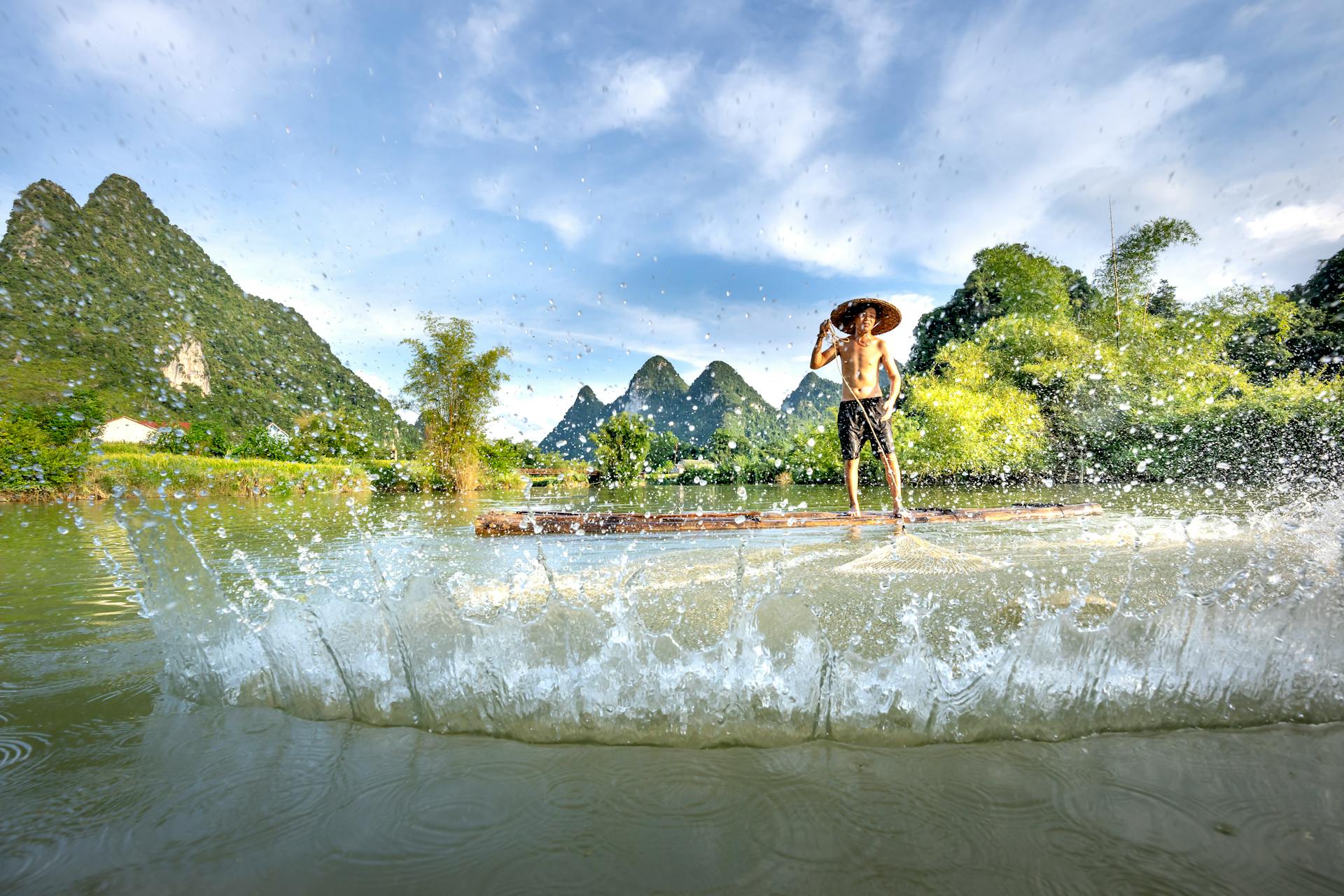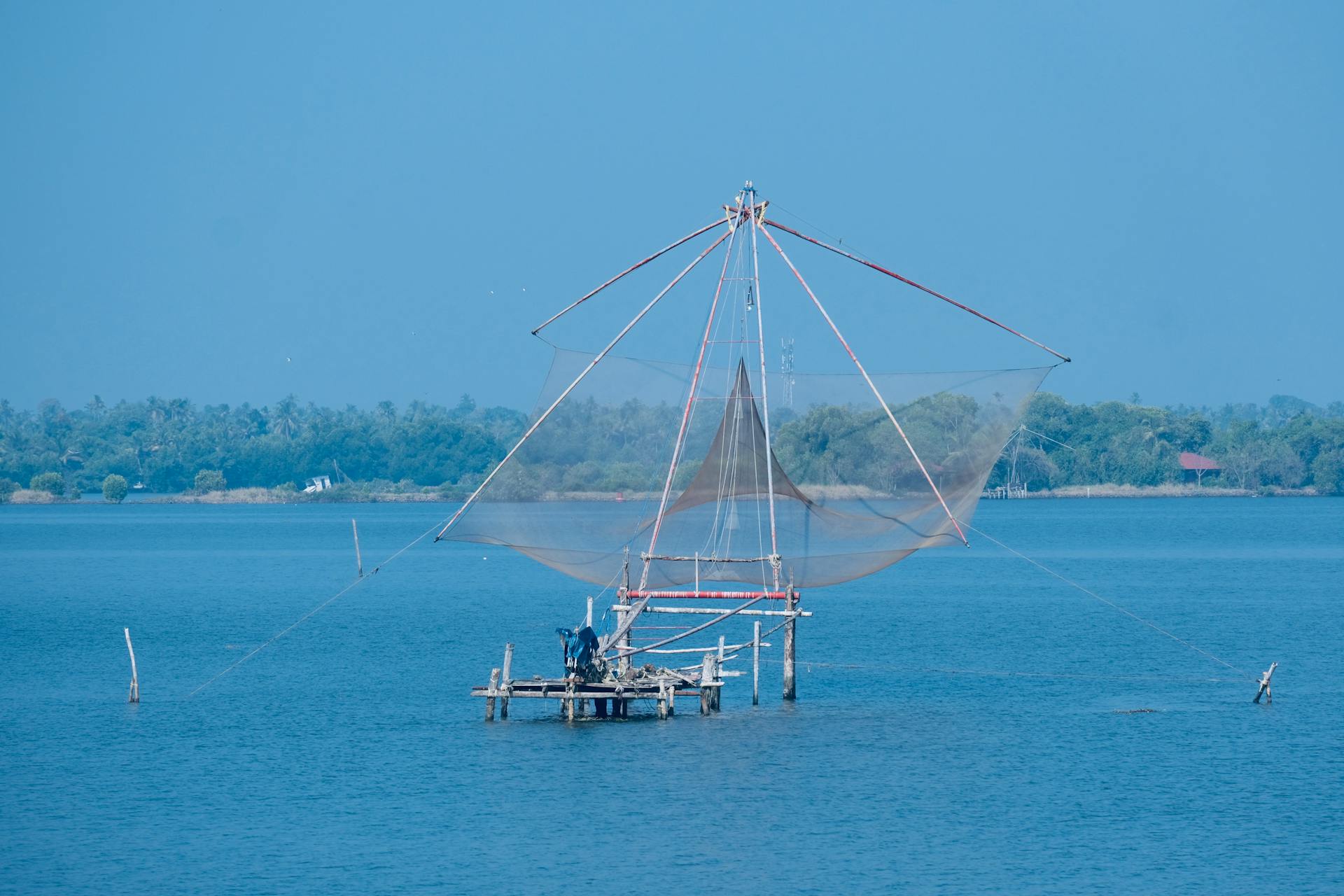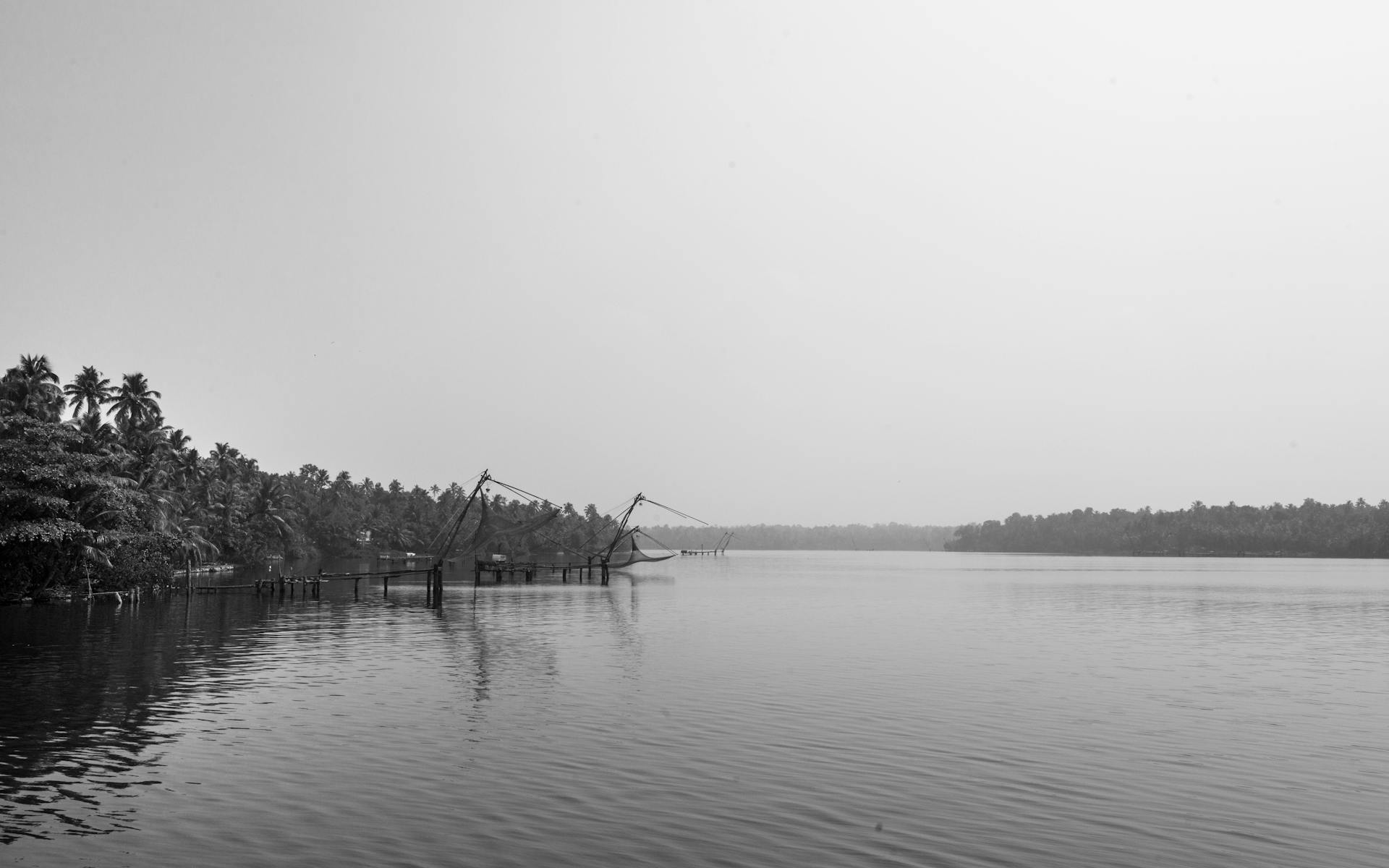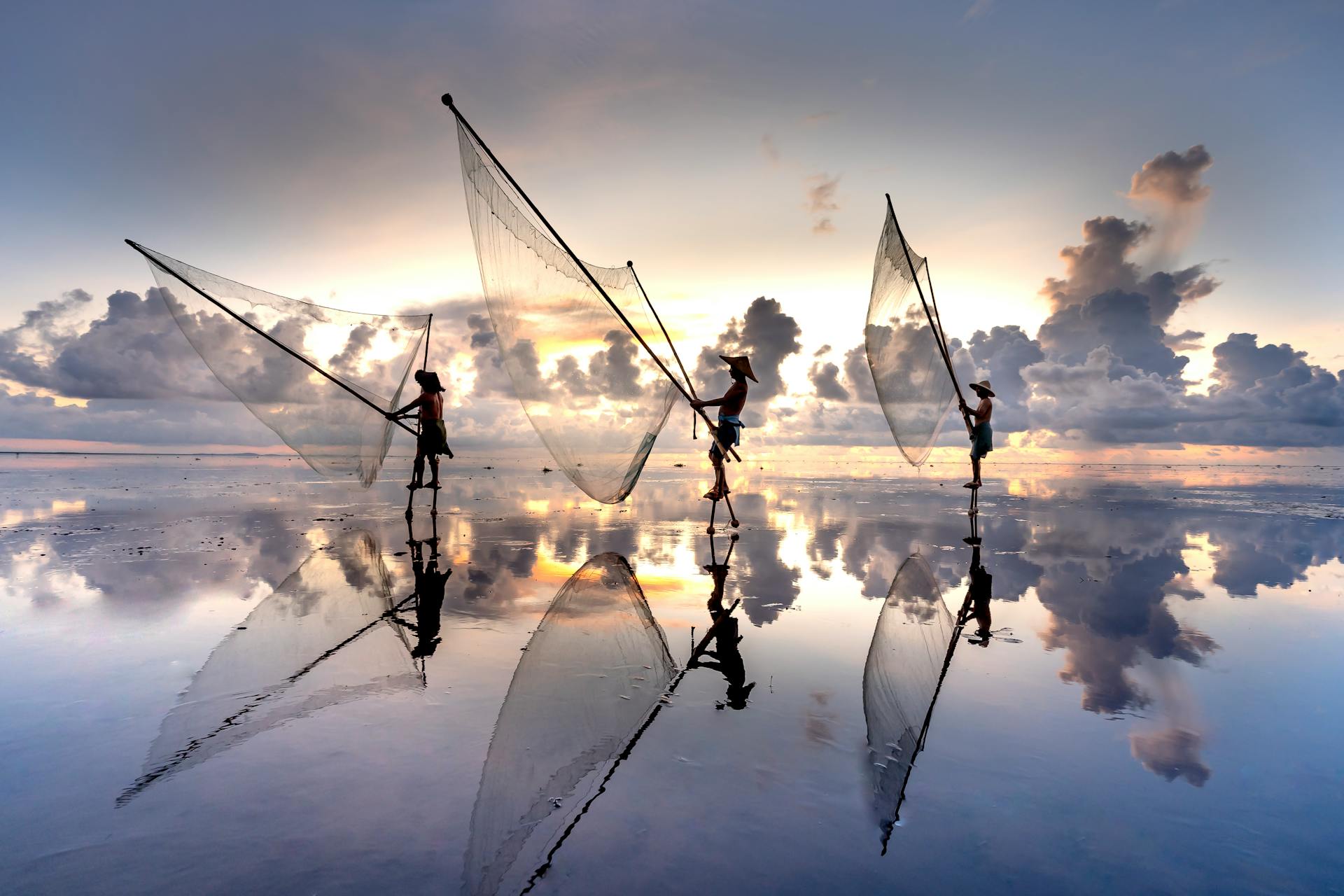
The Chinese Fishing Nets in Cochin, India, are a fascinating blend of tradition and modernity. They are a testament to the region's rich history and cultural exchange.
Located in the bustling port city of Kochi, these massive fishing nets are a popular tourist attraction. They are a sight to behold, with their intricate pulley system and massive net.
The Chinese Fishing Nets were introduced to Cochin by Chinese traders and fishermen in the 14th century. This was a time of great cultural exchange between China and India.
As you walk along the waterfront, you can see the nets in action, with fishermen hauling in the day's catch. It's a scene that has been repeated for centuries.
Chinese Fishing Nets
Chinese fishing nets are a type of stationary lift net found in India and Indonesia, commonly known as "Chinese fishing nets" in India, but formally called "shore operated lift nets".
These massive mechanical contrivances hold out horizontal nets of 20 m or more across, with each structure at least 10 m high and comprising a cantilever with an outstretched net suspended over the sea.
The nets are operated by a team of up to six fishermen, who can raise and lower the net with ease, thanks to the balanced system that allows the weight of a man walking along the main beam to cause the net to descend into the sea.
The catch is usually modest, with a few fish and crustaceans being sold to passers-by within minutes, making it a unique and fascinating experience to watch.
Working Mechanism
The Chinese fishing nets are a remarkable piece of engineering. Each installation is at least 10 m high and comprises a cantilever with an outstretched net suspended over the sea.
A team of up to six fishermen operates each installation. They use large stones suspended from ropes as counterweights to keep the net in balance.
The system is so well-balanced that the weight of a man walking along the main beam is enough to cause the net to descend into the sea. The net is left for a short time, possibly just a few minutes, before it is raised by pulling on ropes.

Rocks, each 30 cm or so in diameter, are suspended from ropes of different lengths. As the net is raised, some of the rocks one-by-one come to rest on a platform, keeping everything in balance.
The nets have a limited operating depth, so an individual net cannot be continually operated in tidal waters. Different installations will be operated depending on the state of the tide.
Cultural Significance
The Chinese Fishing Nets are a remarkable example of cultural significance in the city of Kochi, India.
These nets have been a part of the city's fishing industry for centuries, with the first nets being introduced by Chinese traders in the 14th century.
The nets are a testament to the city's rich cultural heritage, with the Chinese influence still visible in the design and construction of the nets.
The Chinese Fishing Nets are a major tourist attraction in Kochi, with thousands of visitors flocking to see the nets in action every year.
In fact, the nets are so iconic that they've become a symbol of the city's fishing industry, representing the hard work and dedication of the fishermen who use them.
The nets are also a great example of sustainable fishing practices, with the fishermen using a traditional method that minimizes waste and protects the marine ecosystem.
Location and Geography
Chinese Fishing Nets are located in Kochi, a port city in the state of Kerala, India. Kochi is situated on the southwest coast of India, on the Arabian Sea.
The nets are positioned along the shores of Fort Kochi, a historic trading post. This area is known for its rich cultural heritage and colonial architecture.
The Indian Ocean's strong tidal currents and waves create ideal conditions for the nets to operate. The nets are designed to catch fish as the water recedes with the tide.
Kochi's unique geography, with its narrow entrance to the sea, makes it prone to strong tidal variations. This is a major factor in the nets' effectiveness.
Economic Importance
Chinese Fishing Nets have a significant economic impact on the fishing industry. They are a vital source of income for many fishermen in India and China.
The nets are used to catch a variety of fish species, including sardines, mackerel, and prawns. These fish are then sold in local markets.
The fishing nets are often operated by a single person, who can catch up to 20 kg of fish per day. This is a remarkable feat, considering the manual labor involved.
The Chinese Fishing Nets are also an important tourist attraction in Kochi, India. Visitors can watch fishermen hauling in the nets and learn about the fishing process.
The nets are made from durable materials, such as nylon and polypropylene, which can withstand the harsh marine environment. This durability ensures that the nets remain effective for many years.
The fishing industry is a significant contributor to the local economy, providing employment opportunities for many people.
A Borrowed Heritage

The Chinese fishing nets in Cochin, India, have a rich and fascinating history. They're believed to have been brought by traders from the court of Kublai Khan between 1350 and 1450.
These nets are a testament to the cultural exchange that existed in the Indian subcontinent during that time. They're locally known as "Cheena Vala" and are one of the most significant symbols of this exchange.
Each fishing net is about 10 metres in height and spreads to about 20 metres above the water. They're operated by a team of six fishermen and are set up on bamboo and teak poles.
History and Origin
These huge cantilevered fishing nets, known as "Cheena Vala", are believed to have been brought to Kochi shores by traders from the court of Kublai Khan sometime between 1350 and 1450.
Some accounts say Chinese explorer Zhang introduced the nets to Kochi, while others claim the Portuguese from Macau set them up. Irrespective of who brought them first, they are a symbol of the rich exchange of culture and ideas in the Indian subcontinent at the time.

The nets are operated from the shore and are set up on bamboo and teak poles, held horizontally by huge mechanisms that lower them into the sea.
Each fishing net is about 10 metres in height and spreads to about 20 metres above the water, operated by a team of six fishermen.
They have been in use for the last 500 years and are one of the biggest tourist draws in Kerala, but are vanishing fast from the coastline of Kochi due to high maintenance costs and poor catch.
Influence on Local Community
The local community in many towns and cities has been significantly impacted by the influx of tourists visiting to experience their borrowed heritage. This can be seen in the increased foot traffic and economic activity in areas like downtown shops and restaurants.
Tourists often flock to popular sites such as the historic town square, which has been well-preserved and restored to its original grandeur. This has led to a boost in local sales tax revenue.

However, the increased tourism can also put a strain on local resources, such as parking and public facilities. For example, the town's parking garage has seen a significant increase in usage during peak tourist season.
The local community has responded to the influx of tourists by offering a range of services and amenities, including guided tours and cultural events. These initiatives aim to enhance the visitor experience and promote a deeper understanding and appreciation of the town's unique heritage.
The town's historic homes and buildings have also become popular attractions, with many being open to the public for tours and exhibitions. This has helped to raise awareness and appreciation for the town's architectural heritage.
Fort Kochi's Anco
Fort Kochi's Anco is a sight to behold. The shoreline is only thirty meters parallel to the River Road, making it easily accessible from the city.
As I arrived at the edge of the beach, I was struck by the blue expanse of Malabar Beach. The beautiful scenery was added to the routine of the fishermen along the coast.
Fishermen in Fort Kochi use Chinese fishing nets, which are also known as "anco" or "tangkul" in Indonesia. This type of fishing gear is installed on the shoreline, resulting in mostly small fish being caught.
The catch from the operation of the Chinese fishing nets is mostly small fish, while fresh and large fish are transported using pick-up vehicles to be taken out of the beach area.
Sources
- https://en.wikipedia.org/wiki/Chinese_fishing_nets
- https://www.outlooktraveller.com/experiences/heritage/chinese-fishing-nets-kochi
- https://www.tourmyindia.com/states/kerala/chinese-fishing-nets-kochi.html
- https://commons.wikimedia.org/wiki/Category:Chinese_fishing_nets_at_Kochi,_Kerala
- https://travelingpersecond.com/2023/07/27/chinese-fishing-nets-fort-kochis-version-of-anco/
Featured Images: pexels.com


